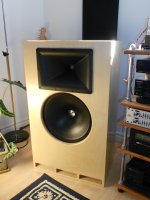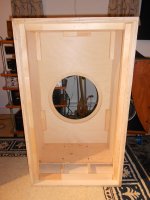WinISD has option of round or rectangular ports. But basically the cross sectional area needs to be kept the same along with length. In the case of very narrow aspect profile slots there is more skin or surface drag that will be more than just the regular slot pressure losses. This is how an Onken reflex is different.
WinISD apparently does not let users enter arbitrary end correction factors, outside of the 4 presets they have, the highest of which is nowhere near enough for a bottom slot port's value of 2.222, if I'm correct.
Funny you should post this today. Just yesterday, I did a tuning adjustment on large enclosures I have for TD15M, with such a vent scheme.


WinISD was little help getting me to where I wanted, but I did it empirically. If you implement a scheme like I did, with a drop-on panel setting vent length, it's easy enough to start too long, measure and adjust until you get it right. Which is basically the boneheaded way to do it lacking proper software or the will to look for it.
Funny you should post this today. Just yesterday, I did a tuning adjustment on large enclosures I have for TD15M, with such a vent scheme.
WinISD was little help getting me to where I wanted, but I did it empirically. If you implement a scheme like I did, with a drop-on panel setting vent length, it's easy enough to start too long, measure and adjust until you get it right. Which is basically the boneheaded way to do it lacking proper software or the will to look for it.
Attachments
Those TD-15 cabinets look amazing. I like your use of cleats!
If the port is only 20cm wide it's not going to need any extra support?
Assuming it's built from 18mm BB-ply, it's probably stiff enough not require support at 20cm width. OTOH, it can't hurt to have some and if you don't want the slot itself to be separated, like mine picture above for example, you can use a triangular brace on top that ties it to the front panel. The advantage with my drop-on-cleats-panel scheme (not that I pretend having invented it
Last edited:
excellent link, Greg
My personal experience with slots is that they work very well - particularly if you get a math geek to calculate, there are several methods to fine tune them, and depending on configuration, can add to enclosure bracing.
 Thanks to bjorno and whoever did the basic one he started with for sharing it with us!
Thanks to bjorno and whoever did the basic one he started with for sharing it with us!Agreed, the first and earliest date, shelf port I saw was a subdivided slot in a custom undersized Altec 604B cab circa 1948. Unfortunately, the driver was blown, so didn't get to audition it and was too expensive for my meager part time lawn maintenance allowance.
The second was in a 1952 Altec 820A horn where it did double duty as a short horn cum pedestal base, so short of contrary eyes-on proof, I'm assuming Altec pioneered slot/shelf/BVR ports.
GM
Thank you.
I was searching for this quite a while (opened a thread.....)http://www.diyaudio.com/forums/pa-systems/272635-br-vent-calculus-round-square.html
I'm designing a box with double 12" woofers and a big tweeter horn.
The box should be designed like a ~1m high tower, shaped like this:
(x=horn, o=woofer, I=slit)
.x.
IoI
IoI
So i guess k=1,728 is correct in this case.
I'll play around with the calculations and report back in this thread.
edit:
i just recognized that i used the word 'slit', but the better english term would be 'slot'.
Last edited:
http://www.diyaudio.com/forums/attac...ort-length.jpg
After a bit of meditation over that sheet i came to the conclusion that k=1.728 is not right for my case.
Even for the lower cab it would still be a special case because of the w/h ratio.
For the upper cab it wouldn't make any sense because the ground is to far away.
What would be the proper k-factor for my case?
After a bit of meditation over that sheet i came to the conclusion that k=1.728 is not right for my case.
Even for the lower cab it would still be a special case because of the w/h ratio.
For the upper cab it wouldn't make any sense because the ground is to far away.
What would be the proper k-factor for my case?
- Status
- This old topic is closed. If you want to reopen this topic, contact a moderator using the "Report Post" button.
- Home
- Loudspeakers
- Full Range
- Slot reflex port for bass reflex enclosure?

